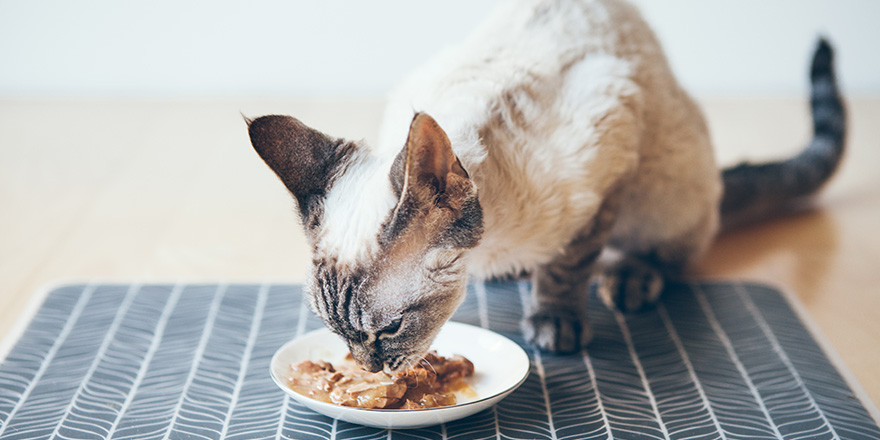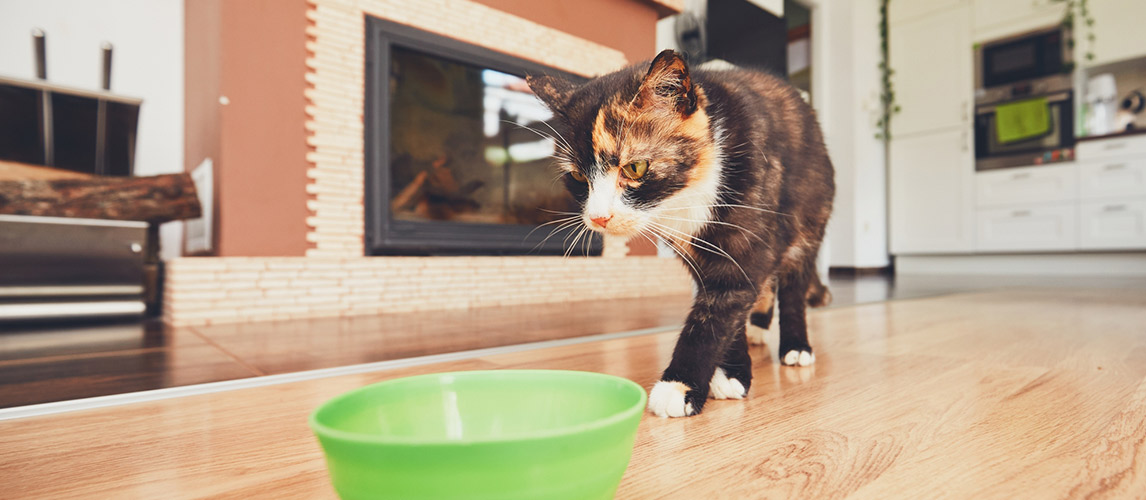If you’re looking to let your cat take a small break from canned cat food, a small amount of fresh or cooked fish is always a good way to go. Cats are obligate carnivores, which means that they need to have meat (including fish) in their diets to thrive. However, when it comes to salmon, there are some things that you should know before you give your cat its first piece.
Can Cats Eat Salmon?
So, you’re wondering if you can give your cat salmon. Well, the good news is that salmon can be a part of your cat’s well-balanced diet with a few restrictions. First, your cat can eat fish – and most types of fish, actually – but uncooked fish can sometimes be hazardous to your cat’s health. Because of this, we’ve gathered as much information about feeding cats salmon as possible and put it all into this guide for you.
Your cat can eat salmon, but that doesn’t mean you should immediately feed them raw salmon, even if it’s freshly purchased from your local fish market. To look out for your feline friend, always know the ins and outs of what you’re feeding them and how to get the most out of the food that you’re offering to them.
Is Salmon Good for Cats?
Salmon is full of protein, omega-3 fatty acids, and a bunch of other nutrients that are great to have in a cat’s diet! When properly prepared, your cat will be able to reap the benefits of having a piece of salmon fed to them as an occasional treat. You could also try switching over to a cat food brand that uses wild-caught salmon in their ingredients, provided that your cat doesn’t have a fish allergy.
There’s a bit of a difference between feeding your cat canned cat food products that contain salmon and feeding them fresh salmon. On the surface, it might seem more beneficial to feed your cat fresh salmon rather than canned food, but you have to consider that canned food contains more of the daily recommended nutrients that your cat needs. Salmon can’t make up the entirety of your cat’s diet by itself.

Benefits of Eating Salmon
The benefits of feeding salmon to your cat are vast! We’ve already mentioned its high protein levels and that it contains omega-3 fatty acids, but what does that mean? Below, you’ll find a quick list of the benefits of giving your can salmon and what salmon can do for your cat:
Salmon is High in Protein
- This can help with muscle and bone development in cats.
- The lean protein in salmon may also escalate the healing process for any injuries your cat has, promoting healthy skin.
- Protein-rich foods can increase metabolic rates, helping with weight management.
Salmon is High in Vitamin B
- Salmon includes Vitamin B1, B2, B3, B5, B6, B9, and B12.
- B vitamins help create more energy.
- They can also enhance the function of the brain and repair your cat’s DNA.
Salmon has Long-Chain Omega-3 Fatty Acids
- These acids can boost your cat’s immune system through their high number of antioxidants.
- They have the potential to reduce the likelihood of your cat developing chronic health conditions, such as arthritis in cats, kidney disease, and diabetes.
- Omega-3 fatty acids also have anti-inflammatory properties and are sometimes used to help cats fight cancer.
Salmon Contains Astaxanthins
- These antioxidants are what give salmon its pink-red color.
- They have been researched for their use against the risk of heart disease.
- They have the potential to help with increasing good cholesterol and lowing bad cholesterol.
Salmon has a Good Amount of Potassium
- Potassium can help maintain your cat’s cells and cellular functions.
- It can also help control your cat’s blood pressure by reducing blood pressure spikes.
- Potassium works with other antioxidants to reduce the risk of heart disease and strokes.
Can Cats Eat Raw Salmon?
They can, but they shouldn’t. It may be tempting to cut out the effort and give your cat raw salmon, fresh from its packaging, but you could be doing your can more harm than good if you decide to do this.
Raw fish that hasn’t been cooked in any way could give your cat food poisoning from E. coli or salmonella. This is because raw fish also contains thiaminase, an enzyme that destroys the thiamine in your cat’s body. Thiamine is an essential B vitamin that your cat needs to thrive.
It’s not just raw salmon that poses this threat, either. It’s any raw fish! Even tuna, which has often been thought of as a favorite of cats, should be cooked first to destroy any possibility of your cat contracting food poisoning from the fish. Of course, your cat can eat tuna and salmon, as long as you cook it first.
Can Cats Eat Cooked Salmon?
Yes! This is the best kind of salmon to feed your cat. Cooked salmon is miles better for your cat than canned salmon or raw salmon. There’s no risk of food poisoning (provided that you cook it properly), and you can include it in your cat’s homemade raw food diets once it’s cooked.
Raw food doesn’t mean that you don’t cook any food. However, it can be very dangerous for novice pet parents to try raw cooking because many videos show uncooked meals. Fish should always be cooked, even when it’s not part of a regular, balanced meal.
How to Cook Salmon for Cats
Before we go into properly cooking salmon for your cat, let’s take a moment to talk about smoked salmon and canned salmon. You mustn’t feed your cat any canned or cooked salmon that has been smoked, and you should also avoid all other kinds of canned salmon.
When cats eat canned salmon, they’re eating salmon that has been treated to have a longer shelflife, which means the fish has a much higher sodium level than your cat needs. It’s the same for smoked and cured salmon. High levels of salt are dangerous for cats. Only feed your cat plain, cooked salmon.
How to prepare cooked salmon for your cat:
- Do not use any salt, butter, oil, or seasoning to prepare your cat’s salmon. It should be cooked completely plain. The fish oil in the fish will be more than enough to cook it in.
- Prepare your fresh salmon by removing any bones and other undesirable parts of the fish, depending on whether you brought a whole salmon or just the fillets.
- Wrap your salmon in parchment paper or foil, similar to cooking other types of fish.
- Cook your salmon in your oven for around 15 minutes. Thicker cuts of salmon may need more cooking time. Flip the salmon over halfway through the cooking time.
- Your salmon will be cooked when the flesh is a solid pink color with white lines.
As an alternative to baking your salmon, you can also poach it in a non-stick pan with a couple of tablespoons of water. Instead of water, you may also use broth, but this must be sodium-free broth and not any regular old broth you usually have in your home. Cooking like this only takes three or four minutes on each side.

How Much Salmon is Too Much Salmon?
As far as cat foods go, it’s not recommended to feed salmon to kittens because their stomachs are much more sensitive, and they may experience some of the more adverse side effects to eating a new and rich food like salmon.
There is, however, no real rule as to how much salmon you can feed an adult cat. Cats can eat salmon, even the salmon found in commercial cat foods, but when you’re feeding your cat fresh, cooked salmon, treat it as a tasty treat and not a part of their regular diet. Salmon is one of those human foods that can be too heavy for a cat’s stomach, so stick to small amounts and feed it to your cat like fishy treats that they can enjoy a couple of times a week.
If you want your cat to have more salmon in their diet without the bother of cooking it, you could find a commercial cat food brand that offers various flavors where one type includes salmon. That way, your cat can enjoy the fish as more than a good salmon cat treat.
FAQs:
They shouldn't. It can be tempting to give your cat a piece of raw fish but there are so many things that can go wrong when feeding raw fish to a feline. Not only would you be putting your cat at risk of contracting food poisoning, but there's also the choking hazard that comes with all of the tiny fish bones you may not have thought to remove from a whole fresh fish. There are no health benefits to raw fish that outweigh cooking that same fish for your cat.
It doesn't matter if your cats are eating canned food, dry cat food, or they're on raw protein diets, never feed your cat raw fish. That said, canned tuna in spring water is fine for cats to eat. As a rule, remember that raw fish puts your cat at risk of mercury poisoning, food poisoning, and has no additional nutritional benefits when compared to cooked fish.
Salmon skin is safe for cats to eat, even though we avoid it for human consumption most of the time. If you're going to feed your cat salmon skin, you should make sure that it is cooked with the rest of the salmon, and only a small amount is given as a healthy treat. There are plenty of healthy fats in salmon and salmon skin, but you should remember that the skin is higher in fat than the meat of the fish.







